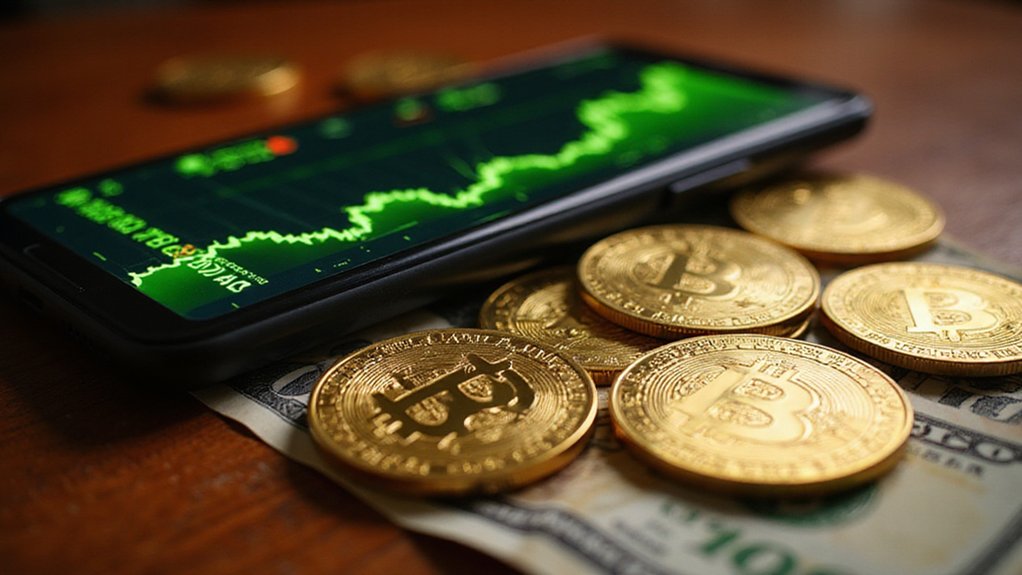Trading meme coins effectively requires a delicate balance of opportunism and caution. Prudent traders monitor social platforms for emerging trends, employ technical analysis despite market irrationality, and implement strict risk controls—never investing more than they can afford to lose. Position sizing matters enormously; allocate no more than 5-10% of a portfolio to these capricious assets, maintain stop-loss discipline, and preserve substantial liquidity for swift exits. The truly sophisticated understand that meme markets reward those who combine community intelligence with unwavering risk management.

Where traditional investment vehicles once dominated the financial landscape, meme coins have emerged as the enfants terribles of cryptocurrency markets—capricious, unpredictable, and occasionally stupendously lucrative.
These digital assets, often born from internet culture and propagated through social media virality, require a distinct trading approach that balances opportunism with prudence.
Successful traders recognize that behind the cartoonish facades of many meme tokens lies genuine market dynamics worthy of serious analytical consideration.
Beneath the Doge faces and rocket emojis exists a complex market ecosystem demanding sophisticated trading strategies.
Effective meme coin trading begins with diligent research—monitoring social platforms, cryptocurrency forums, and community engagement metrics to identify emerging opportunities before they achieve mainstream recognition.
Technical analysis, utilizing indicators such as RSI and Moving Averages, provides objective entry and exit signals amidst the emotional tumult that frequently characterizes these markets.
The astute trader employs these tools not as oracles but as guideposts in an admittedly irrational landscape.
Risk management remains paramount in this volatile sector.
Implementing stop-loss orders, practicing disciplined position sizing, and maintaining emotional equilibrium during inevitable market gyrations separate the survivors from the casualties.
Scalping—the practice of capturing small price movements through frequent, brief trades—has proven particularly effective for meme coins, where price action can resemble a cardiac patient’s ECG during a stress test.
Portfolio construction demands strategic allocation: a foundation of established cryptocurrencies (Bitcoin, Ethereum) supporting a smaller allocation (20-30%) to speculative meme assets. Investors should be aware that meme coins typically lack strong fundamentals compared to established cryptocurrencies.
This approach—maintaining substantial liquidity while exposing oneself to potential exponential growth—reflects the asymmetric risk-reward profile inherent to the sector.
Regular rebalancing prevents overexposure after significant price movements.
When selecting specific meme coins, traders prioritize liquidity, community support, and potential catalysts.
The most promising candidates boast robust trading volumes, active development teams, and tangible use cases beyond memetic appeal.
Popular options like Dogecoin and Shiba Inu have established themselves as mainstays with strong community backing and greater stability than newer entrants.
Market sentiment analysis—tracking social engagement metrics and conversation volume—provides context for technical indicators.
In a market where narrative frequently trumps fundamentals, understanding psychological drivers becomes as vital as analyzing price patterns.
Frequently Asked Questions
What Tax Implications Should I Consider When Trading Meme Coins?
Traders must navigate a complex tax landscape with meme coins.
All transactions—sales, conversions, and rewards—require reporting, with income taxation applying to coins received as payment (at fair market value) and capital gains tax on profits from sales.
Holding periods matter greatly; coins kept over a year qualify for lower long-term rates.
While wash sale rules don’t technically apply, tax loss harvesting remains viable.
Given cryptocurrency taxation’s byzantine nature, professional consultation proves prudent for most traders.
How Can I Identify Potential Pump and Dump Schemes?
Identifying pump and dump schemes requires vigilance toward several telltale indicators.
Investors should scrutinize unexplained price surges coupled with unusual volume spikes, particularly in low-market-cap assets with minimal utility.
The proliferation of hyperbolic promotion—often via encrypted messaging groups or coordinated social media campaigns—warrants immediate skepticism.
Unrealistic price targets, celebrity endorsements without substantive backing, and the sudden appearance of “once-in-a-lifetime” opportunities (aren’t they always?) represent quintessential red flags that demand rigorous due diligence.
Are Hardware Wallets Necessary for Meme Coin Security?
Hardware wallets aren’t strictly necessary for meme coin security, but they represent the gold standard in cryptocurrency protection.
While software alternatives exist, they can’t match the air-gapped security of physical devices that keep private keys offline.
The necessity ultimately depends on one’s risk tolerance and holdings value—a $50 DOGE position hardly warrants a $100 hardware investment, whereas substantial portfolios benefit greatly from this extra layer of protection against both sophisticated hacks and momentary lapses in judgment.
Which Exchanges Offer the Lowest Fees for Meme Coins?
For bargain-hunting meme coin traders, MEXC Global leads the pack with remarkably low 0.05% maker/taker fees while offering extensive coverage of both established and trending meme assets.
WhitBIT’s derivatives structure (0.01-0.035%) presents an enticing alternative for futures enthusiasts.
Savvy traders might leverage Binance’s BNB discount (reducing fees to 0.02-0.075%) or pursue volume-based reductions on platforms like OKX and KuCoin, where holding native tokens can slash trading costs by 10-25%.
Should I Follow Social Media Influencers for Meme Coin Tips?
Following social media influencers for meme coin tips presents a double-edged sword.
While influencers offer market insights and trend awareness, they often operate in regulatory gray zones with undisclosed financial incentives.
Prudent investors should view influencer recommendations as mere starting points for independent research rather than definitive investment signals.
The cardinal rule? Subject every tip to rigorous scrutiny, diversify holdings, and remember that the most enthusiastic online cheerleaders are rarely the ones covering your losses.









